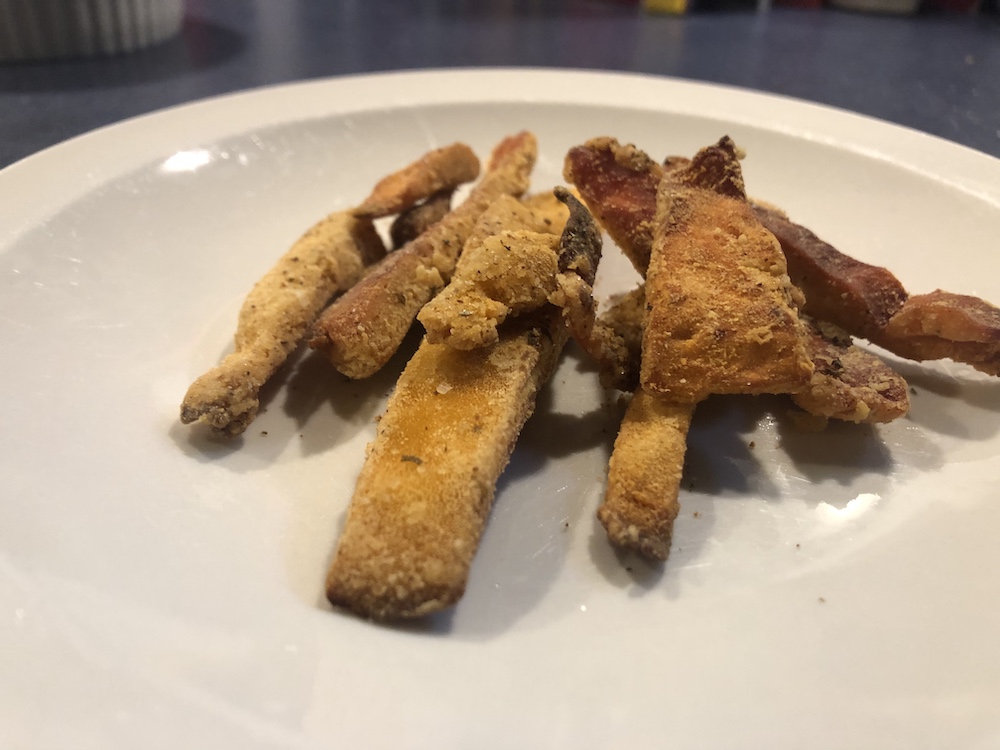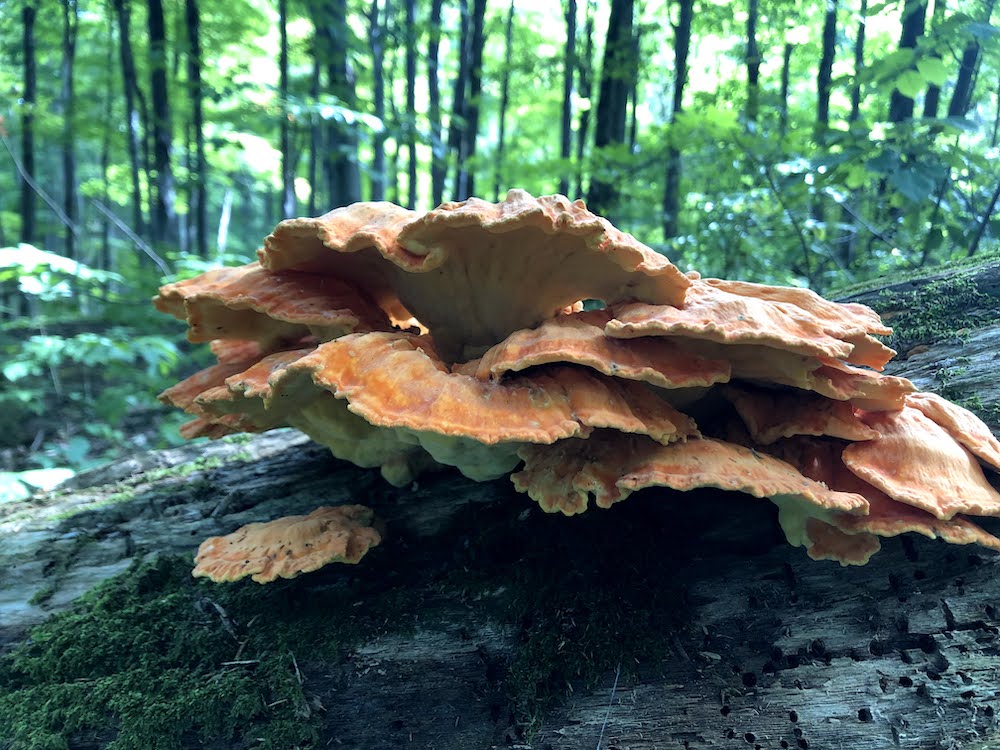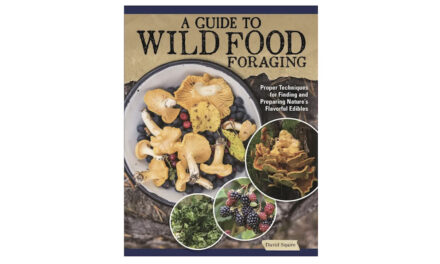Because of its distinctive orange/yellow colouration the Chicken Of The Woods (Laetiporus sulphureus) is quite easy to spot, even from afar.
Good Food Revolution Health Warning:
Before we go any further, please do not consume any wild mushrooms unless you are 100% sure that it is safe to do so.
Be sure to have an expert confirm the identity of any mushroom you find in the wild.
If you are in any way unsure, please err on the side of caution and live to forage another day.
All edible fungi MUST be cooked before ingestion.
For over a decade or so I have observed that as a culture we are becoming less and less attached to the earth that supports us with each passing day, and indeed it was co-founder Malcolm Jolley’s and my own mutual concerns about this that led to the founding of Good Food Revolution way back in 2010.
Today, when we get hungry for protein, most run to the supermarket and pick up a pack of shrink-wrapped meat, seldom giving a second thought as to how that meat got to the grocery shelf. And so, with a view to getting closer to the source of my food than most would be comfortable with, I decided in the fall of 2016 (mere days after the US election – no coincidence there) to learn how to hunt.
Running in parallel to my new found interest (read: midlife crisis) came a related passion for self-sufficiency that upon occasion flirted with the concept of survivalism. Being a voracious information sponge, I gorged upon mountains of books and websites, and in my deep-dives I read over and over again that if the world did really fall apart and one had to live off the land, it wouldn’t be big game that one would be surviving upon, it would be the smaller critters: rabbit, hare, squirrel… and in the case of last month’s piece, the lowly frog.
This month we look at my first foray into the world of foraging for wild mushrooms with the Chicken Of The Woods.

This example here is a little long in the tooth, but the yellow edges are still incredibly tender so harvest by cutting off the edges around 5cm to 8cm in.
Now I’m no mycophagophobe, but until the other week I had given wild mushrooms a wide berth; I put this down to my Scottish mother scaring the utter crap out of me as a child with tragic tales of mushroom poisonings, and to this day I still have nightmares that I’ll pick and cook something that hospitalizes the entire family or worse. Harvesting wild mushrooms is not for the fairweather forager, as a great deal of attention has to paid to the correct identification of the many species that can be found, what with many of them being dangerously toxic.
With this in mind, don’t put all of your faith in a mushroom identification app, as those things can be notoriously unreliable and we are talking about what could possibly be a life or death situation, for you and anyone else you serve them to. I did use an app (Picture Mushroom), but only in combination with Tom Cervenka’s Wild Edible Mushrooms of Ontario: A Field Guide, and most importantly of all the consultation of an expert in mycology (I happened to have the wonderful Anton Potvin on speed dial).
I think it would be fair to state that Chicken Of The Woods is one of the safer mushrooms to forage for due to its extremely distinctive appearance and its relative lack of dangerous lookalikes, but we’ll discuss this further a little later.
The Chicken Of The Woods mushroom is from the Laetiporus genus of edible mushrooms, hence its scientific name Laetiporus sulphureus. Laetiporus means “with bright pores” (more on that later) and sulphureus means the colour of sulphur.
It is also known as “Chicken Fungus”, “Crab Of The Woods”, “Chicken Mushroom”, and the gastrically-ominous-sounding “Sulphur Shelf”. Although the nomenclature is similar, it should not be confused with the (also edible) “Hen Of The Woods”, “Ram’s Head”, or Maitake (Grifola frondosa) mushroom which gets its moniker from its resemblance to a hen’s (read: chicken’s) plumage.
The Chicken Of The Woods gets its name from the fact that it tastes remarkably like chicken… yes… seriously.
It blew my mind.
And now for some nutritional facts: Chicken of the Woods is a good source of Potassium and Vitamin C. 100g of Chicken of the Woods contains 23 calories, 6g of carbs, 3g of fibre, 14g of protein, 1g of fat, 150mg of potassium, 10% of daily Vitamin C, and 5% of Vitamin A. That’s a LOT of protein.
Besides being a favoured edible mushroom, Chicken Of The Woods is also used medicinally in some traditional cultures and has a long history of use in folk medicine, especially in Europe. It has also been powdered and used as snuff. Who knew?
Medicinally, Chicken Of The Woods is extremely rich in antioxidant compounds like chlorogenic acid, caffeic acid, kaempferol, and quercetin. It’s also packed with lanostanoids, supposedly potent anti-carcinogenic compounds. In addition it apparently has a rather potent ability to inhibit staph bacteria, as well as moderate ability to inhibit the growth of Bacillus subtilis.

You usually won’t find just one, as they tend to hang about in sizeable groups. Remember, they freeze incredibly well in their raw state.
First described by French botanist and mycologist Jean Baptiste Francois (Pierre) Bulliard in 1789, the Chicken Of The Woods was given its current name in 1920 by the famous American mycologist William Alphonso Murrill (1869 – 1967).
In some parts of the world, like Germany and some regions of the USA, Laetiporus is seen as a pest, since it causes brown rot, a type of tree decay. Historically, it is recorded that this particular fungus was known to damage the wooden hulls of the British Navy.
The Chicken Of The Woods has a vast distribution around the globe, being found in North America, Europe, and in some areas of Asia. In Canada it can be found for around six to eight months of the year from late spring until early fall. Anything found out-with this timeframe probably isn’t Chicken Of The Woods. Veteran COTW hunters advise me that going out a few days after a summer thunderstorm is the best for larger harvests.
It is a bracket fungus, meaning that they characteristically produce woody, shelf-or-bracket-shaped fruiting bodies that are known as conks. You will most probably see them in a fan and semi-circular shape with a yellow and bright orange wavy cap. If the mushroom you are observing doesn’t have this particular outward appearance, then you should be wary of it, as it may not be a Chicken Of The Woods.
This bright orange/yellow colourization also makes them particularly easy to spot from a distance. As the mushrooms mature this vibrant colour fades, with the whole cap becoming lighter, brittle and crumbly. They can be sized anywhere from 5 to 30 cm across, up to 20 cm deep, and up to 3 cm thick. Only harvest young examples when the flesh of the cap is soft yet thick with a watery feel; it will be smooth to finely wrinkled with a suede-like texture.
Chicken Of The Woods are saprotrophic in nature, that is to say that they feed upon nonliving organic matter known as detritus at a microscopic level, and for this reason will be found growing (often in quite large numbers) at the base of dead or dying hardwood trees. It prefers dead oak trees, but can be found on most dead hardwoods. With this in mind, only harvest Chicken Of The Woods from deciduous trees as those growing on yew trees or conifers (pine, cedar) may absorb oils which can cause serious gastric distress or worse (especially in the case of yews, as the fungus absorbs the toxic alkaloids Taxine and Taxane).
Another distinguishing feature is the yellow underside, as it is a member of the polypore family and has thousands of microscopic pores instead of gills. Indeed it is this gill-free porous underside that thankfully distinguishes the Chicken Of The Woods from its one poisonous lookalike, the Jack-O-Lantern (Omphalotus olearius).
As a side note, the toxic Jack-O-Lantern mushroom exhibits bioluminescence, or rather it glows in the dark much like a firefly. A blue-green colour can be observed from the gills of fresh specimens in low light conditions due to the presence of an enzyme called Luciferase, acting upon a compound called Luciferin, leading to the emission of light. Creepy… especially as at the root of that enzyme and compound is the word… …Lucifer.
Crikey.

Not only do they look like chicken when cut, they taste like chicken too. Note the porous yellow underside here… no gills. This is very important when identifying this fungus.
The Chicken Of The Woods can also occasionally be mistaken for younger specimens of the Velvet Top fungus (Phaeolus schweinitzii). The Velvet Top isn’t terribly toxic per se, but it’s certainly not edible as it tastes bloody disgusting. Unlike the Chicken Of The Woods, it is usually brown and velvety on the top surface and tends to be tough and hard.
It’s best not to break off the whole conk of the Chicken Of The Woods mushroom, and much better to use a knife to cut off the thinner younger cap towards the edges, as it’s often the centre of the fungus that is old and woody/corky.
You’ll also want to check that your Chicken Of The Woods isn’t riddled with bugs. Give them a good shake when harvesting as one will often find a veritable colony of beetles hiding within the moist folds of the fruiting bodies.
When preparing for cooking one must use a fine mushroom brush to remove any dirt before wiping down with a damp cloth (they are too sponge-like to wash) and then cutting the mushroom into strips and closely examining for larval burrows, discarding any pieces where one finds any. Occasionally these mushrooms can be simply crawling with maggots. You really don’t want to be eating any of that. Not pleasant at all.
A word of warning: although it is relatively rare, some people can have adverse reactions (swollen lips, nausea, vomiting, dizziness, disorientation, and, of course the dreaded gastrointestinal unpleasantness) to Chicken Of The Woods and it is thought that this may be due to allergies concerning the proteins contained within or the inherent toxins which are “only somewhat stable” at the high temperatures brought about through cooking. These toxins are found in higher concentration in the older, thicker, “woodier” sections of the mushroom, the cork-like bits you should have left on the tree.
Upon your first experiments with this mushroom it’s best practice to cook off and eat just a small piece of your haul at first, perhaps the day before you plan to cook them, to see how your body deals with it.
I had to do this with the whole family… thankfully we were all good.

Simply sautéed in butter and garlic, Chicken Of The Foods is a dead ringer for fried chicken.
One can store them in a paper bag in the refrigerator before cooking, but for no longer than a week.
Also, if you have been a little overzealous in your harvesting and have huge quantities of the stuff, it freezes amazingly well when raw, and can be kept in the freezer for up to 12 months with very little impact upon texture and flavour.
As for cooking the Chicken Of The Woods, I find the simpler the preparation the best, so I tend to go for a sautée in loads of butter, garlic, and herbs (thyme and oregano work particularly well), allowing the mushrooms to colour all over and get a little crispy around the edges; I also throw in around 1/4 to a 1/2 a glass of water or white wine. After at least 10 minutes I mount the cooked strips of COTW on toasted sourdough and pour any of the buttery goodness in the pan over the top. Top with some torn parsley. Divine. Just be cautious of how much butter you use here, as the COTW can absorb a hell of a lot of it due to its porous and spongey nature.
Just be sure to cook them for at least 10 minutes or your guts will be in for a world of hurt, not to mention extended and repeated visits to the bathroom.
Alternatively, one can use flour, garlic powder, herbs, salt and pepper to coat moistened strips of COTW before dipping them into beaten eggs then breadcrumbs and finally deep frying as one would do with chicken. The ten minute cooking time applies to this recipe also.
One can also make an absolutely killer omelette with them, having first sautéed as above before adding to the cooking eggs.
A friend pointed me to a few YouTube videos where people were turning them into Popeye’s or KFC taste-alikes, but each to their own.
The taste is decidedly chicken-like, that’s for sure, but sometimes the flavours are more lemony or lobster-like. I guessing that this may depend upon the host tree? For further investigation…

Some shallow-fried Chicken Of The Woods strips coated in flour, garlic powder, herbs, salt and pepper. Hit with a squeeze of lemon and some torn parsley.
I’ve been feeling pretty satisfied with my first journey into the world of foraging wild mushrooms, and am now quietly confident in my ability to correctly identify Chicken Of The Woods every time.
Over the last three weeks I’ve discovered a handful of local spots where this amazing fungus grows on a regular basis, so I can see myself returning year after year to harvest this glorious bounty of the forest.
Just remember to be 100% sure of the identity of any wild mushrooms you choose to consume.
Be careful out there.







